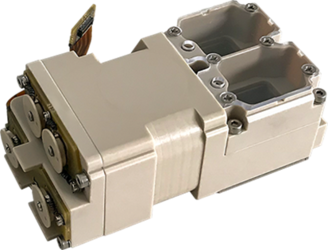Accept all cookies Accept only essential cookies See our Cookie Notice

About ESA
The European Space Agency (ESA) is Europe’s gateway to space. Its mission is to shape the development of Europe’s space capability and ensure that investment in space continues to deliver benefits to the citizens of Europe and the world.
Highlights
ESA - United space in Europe
This is ESA ESA facts Member States & Cooperating States Funding Director General Top management For Member State Delegations European vision European Space Policy ESA & EU Space Councils Responsibility & Sustainability Annual Report Calendar of meetings Corporate newsEstablishments & sites
ESA Headquarters ESA ESTEC ESA ESOC ESA ESRIN ESA EAC ESA ESAC Europe's Spaceport ESA ESEC ESA ECSAT Brussels Office Washington OfficeWorking with ESA
Business with ESA ESA Commercialisation Gateway Law at ESA Careers Cyber resilience at ESA IT at ESA Newsroom Partnerships Merchandising Licence Education Open Space Innovation Platform Integrity and Reporting Administrative Tribunal Health and SafetyMore about ESA
History ESA Historical Archives Exhibitions Publications Art & Culture ESA Merchandise Kids Diversity ESA Brand Centre ESA ChampionsLatest
Space in Member States
Find out more about space activities in our 23 Member States, and understand how ESA works together with their national agencies, institutions and organisations.
Science & Exploration
Exploring our Solar System and unlocking the secrets of the Universe
Go to topicAstronauts
Missions
Juice Euclid Webb Solar Orbiter BepiColombo Gaia ExoMars Cheops Exoplanet missions More missionsActivities
International Space Station Orion service module Gateway Concordia Caves & Pangaea BenefitsLatest
Space Safety
Protecting life and infrastructure on Earth and in orbit
Go to topicAsteroids
Asteroids and Planetary Defence Asteroid danger explained Flyeye telescope: asteroid detection Hera mission: asteroid deflection Near-Earth Object Coordination CentreSpace junk
About space debris Space debris by the numbers Space Environment Report In space refuelling, refurbishing and removingSafety from space
Clean Space ecodesign Zero Debris Technologies Space for Earth Supporting Sustainable DevelopmentLatest
Applications
Using space to benefit citizens and meet future challenges on Earth
Go to topicObserving the Earth
Observing the Earth Future EO Copernicus Meteorology Space for our climate Satellite missionsCommercialisation
ESA Commercialisation Gateway Open Space Innovation Platform Business Incubation ESA Space SolutionsLatest
Enabling & Support
Making space accessible and developing the technologies for the future
Go to topicBuilding missions
Space Engineering and Technology Test centre Laboratories Concurrent Design Facility Preparing for the future Shaping the Future Discovery and Preparation Advanced Concepts TeamSpace transportation
Space Transportation Ariane Vega Space Rider Future space transportation Boost! Europe's Spaceport Launches from Europe's Spaceport from 2012Latest

Microbial wipe down
Thank you for liking
You have already liked this page, you can only like it once!
Sometimes doing science is as simple as wiping up. NASA astronaut Jack Fisher is seen here using a wet wipe on the surfaces of the European Cupola module of the International Space Station.
Doubling as both Station maintenance and science experiment, Jack collected microbes living on the surfaces of his orbital home for ESA’s Extremophiles experiment. Headed by Dr. Christine-Moissl Eichinger from the Medical University of Graz, Austria, the experiment studies how microbes settle into the harsh environment of space.
Cosmic radiation exposes not only humans but also bacteria, fungi, and other microorganisms to cellular stress. A typical stay in microgravity for an astronaut weakens the immune system and causes more health issues, prompting researchers to ask whether the same was happening to microbiomes, or the organisms found in a particular environment, and whether they resist treatment, becoming ‘super bugs.’
Because the Space Station is a closed environment, microbes can only arrive with new crew and cargo. The Station has accumulated a core group of 55 microbes over 20 years of continuous human inhabitants.
Researchers tested these against microbes found in a similar environment on Earth: spacecraft cleanrooms. They found that space-based microbes did not have a higher resistance and were not more stressed than Earth-based ones.
In short, microbes are no more extremophilic – able to survive in uninhabitable environments – in the weightless and radiative environment of space. The results were recently published in a paper in Nature Communications.
Interestingly, researchers found that space-based microbiomes can react negatively to metal surfaces, especially when those surfaces are wet. As they struggle to adapt to their environment, they attack the metal surfaces they find themselves on by corroding them or creating biofilm.
Researchers and crew are monitoring the situation by keeping metal surfaces dry and easily accessible for regular cleaning and sampling.
After all, there is no getting rid of microbes or any need to. They are a fact of human life.
-
CREDIT
ESA/NASA -
LICENCE
ESA Standard Licence

Film and cultures

BioRock

BioAsteroid

Touching surfaces experiment















 Germany
Germany
 Austria
Austria
 Belgium
Belgium
 Denmark
Denmark
 Spain
Spain
 Estonia
Estonia
 Finland
Finland
 France
France
 Greece
Greece
 Hungary
Hungary
 Ireland
Ireland
 Italy
Italy
 Luxembourg
Luxembourg
 Norway
Norway
 The Netherlands
The Netherlands
 Poland
Poland
 Portugal
Portugal
 Czechia
Czechia
 Romania
Romania
 United Kingdom
United Kingdom
 Slovenia
Slovenia
 Sweden
Sweden
 Switzerland
Switzerland

























